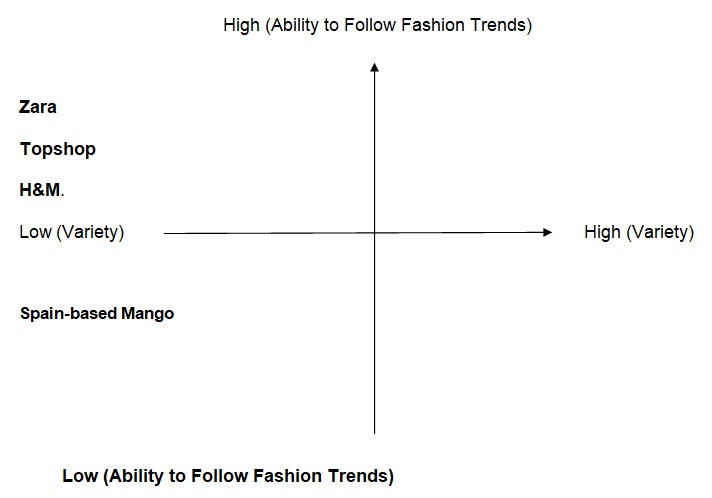Product Positioning Map
It is possible to single out several elements on which Zara competes; the most important elements are the ability to follow fashion trends and the variety of the items which they manufacture. Zara produces approximately 11.000 different items of clothing. Moreover, this company has established a well-developed supply chain and they can bring new articles of clothing every two weeks (Tiplady, 2010, unpaged). Thus, one can construct a product positioning map based on these attributes

Primary Target Markets
The target audience of Zara is very wide. It includes people of both sexes, whose age ranges from 17 to 30. These people represent the upper-middle classes and their purchasing power is very high. However, one should also mention that Zara manufactures children, especially girls, aged more than seven (Zara, 2011, unpaged).
Product Categories
Zara’s products can be subdivided into several categories: 1) jeans and trousers; 2) jackets; 3) shirts and T-shirts; 4) handbags; 5) belts; 4) footwear and so forth. These items are intended for both male and female customers.
Product-Market Grid.
Thus, we can argue that jeans, jackets, and T-shirts are the most popular of Zara’s products. They are marketed to every group of the target audience. Some of the items of clothing, which they manufacture, are primarily intended for women, for instance, handbags and belts.
Strategy Opportunities
At the given moment, the company should pursue a product development strategy, which means that they need to offer new products to its current customers. For example, Zara can offer a wider range of winter apparel to their customers, both male and female. Secondly, they need to increase the number of footwear items. Currently, they manufacture shoes which are suitable for people, who live in areas with a very warm climate. A product development strategy has been chosen because it will be rather difficult to promote the company’s products to different layers of the population. More importantly, Zara is already well-known among its potential customers, and these people will receive their new articles of clothing favorably.
Product Mix
It is possible to say that Zara does have a competitive advantage which is primarily related to its product mix. This concept can be understood as a range of products that are marketed together (Christ, 2008). The customers of this company prefer to buy several of its clothing items at a time, for instance, T-shirts and cardigans, belts and jeans, knitwear and so forth. Zara’s products create a distinct value for the customers and they prefer to buy a set of clothing articles from this manufacturer rather than from different companies. Certainly, Zara does not force customers to purchase their products as a set of items but in many cases, the customers prefer to do so. In part, it can be explained by the act that these people are not very price sensitive and they are quite loyal to this brand, and this gives Zara a competitive edge.
Reference List
Caro, F., & Gallien, J. (2010). Inventory management of a fast-fashion retail network.Operations Research. Web.
Christ, P. (2008). Principles of Marketing. Know.This.com. Web.
Fournier, S. (1998). Consumers and their brands: Developing relationship theory in consumer research. Journal of Consumer Research. 24(4).
Tiplady. R. (2006). “Zara: Taking the Lead in Fast-Fashion”. Business Week. Web.
Zara. (2011). The Official Website. Web.